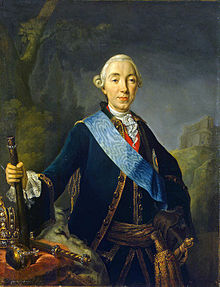
Back Pieter III van Rusland Afrikaans بيتر الثالث Arabic بيتر التالت ARZ III Pyotr Azerbaijani اۆچونجو پتر (روسیه) AZB Пётр III Byelorussian Пётар III BE-X-OLD Петър III (Русия) Bulgarian Petar III, car Rusije BS Pere III de Rússia Catalan
This article needs additional citations for verification. (October 2023) |
| Peter III | |
|---|---|
 Portrait by Lucas Conrad Pfandzelt, c. 1761 | |
| Emperor of Russia | |
| Reign | 5 January 1762 – 9 July 1762 |
| Predecessor | Elizabeth |
| Successor | Catherine II |
| Duke of Holstein-Gottorp | |
| Reign | 18 June 1739 – 9 July 1762 |
| Predecessor | Charles Frederick |
| Successor | Paul |
| Born | Karl Peter Ulrich of Schleswig-Holstein-Gottorp 21 February 1728 Kiel, Holstein-Gottorp, Duchy of Holstein |
| Died | 17 July 1762 (aged 34) Ropsha, Russian Empire |
| Burial |
|
| Spouse | |
| Issue | |
| House | Romanov-Holstein-Gottorp |
| Father | Charles Frederick, Duke of Holstein-Gottorp |
| Mother | Grand Duchess Anna Petrovna of Russia |
| Religion | Russian Orthodox prev. Lutheran |
| Signature |  |
Peter III Fyodorovich (Russian: Пётр III Фёдорович, romanized: Pyotr III Fyodorovich; 21 February [O.S. 10 February] 1728 – 17 July [O.S. 6 July] 1762) was Emperor of Russia from 5 January 1762 until 9 July of the same year, when he was overthrown by his wife, Catherine II (the Great). He was born in the German city of Kiel as Charles Peter Ulrich of Schleswig-Holstein-Gottorp (German: Karl Peter Ulrich von Schleswig-Holstein-Gottorp), the grandson of Peter the Great and great-grandson of Charles XI of Sweden.
Peter III could barely speak Russian and pursued a strongly pro-Prussian policy, which made him an unpopular leader. The two countries were on opposing sides of the Seven Years' War, and Russian troops were threatening Berlin at the time of Peter's accession to the throne. He immediately switched sides in the war and withdrew his troops from Prussia, undoing hard-earned gains. He was deposed by troops loyal to his wife, Catherine, who, despite her own German origins, was a Russian nationalist. She succeeded him as empress. Peter died in captivity soon after his overthrow, perhaps with Catherine's approval as part of the coup conspiracy. However, another theory is that his death was unplanned, resulting from a drunken brawl with one of his guards.[1]
Despite his generally poor reputation, Peter made some progressive reforms during his short reign. He proclaimed religious freedom and encouraged education, sought to modernize the Russian army, abolished the secret police, which had been infamous for its extreme violence, and made it illegal for landowners to kill their serfs without going to court. Catherine reversed some of his reforms and carried through others, notably the expropriation of church property.[2]
- ^ Dixon, Simon (2009). Catherine the Great. London, England: Profile Books. pp. 124–25. ISBN 978-1615237326.
- ^ "Романовы. Исторические портреты".